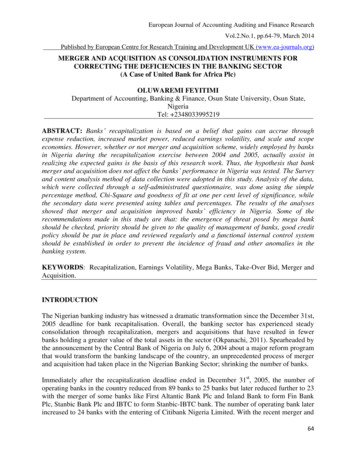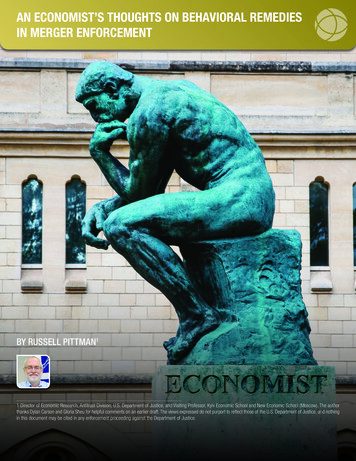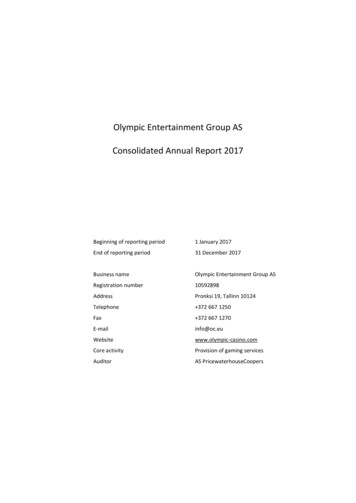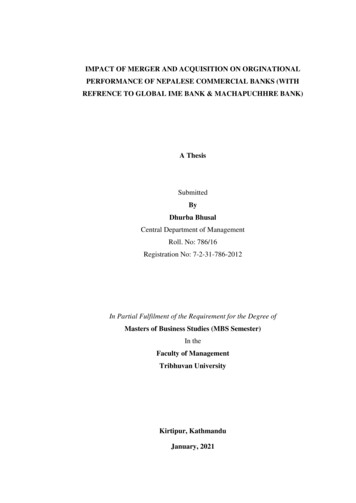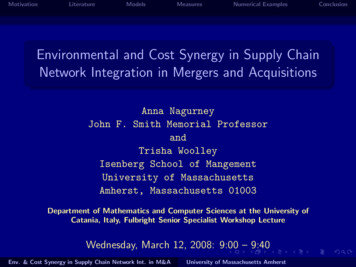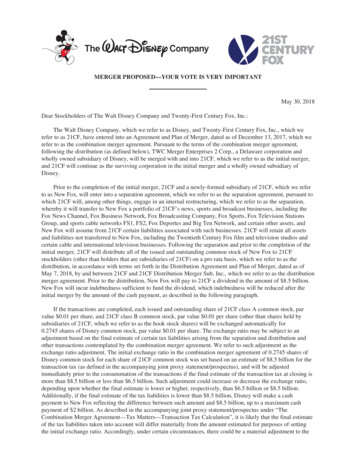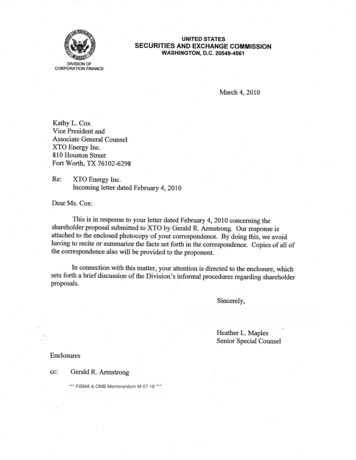
Transcription
UC BerkeleyRecent WorkTitleReinvigorating Horizontal Merger em/4x44j66xAuthorsBaker, Jonathan BShapiro, CarlPublication Date2007-04-10eScholarship.orgPowered by the California Digital LibraryUniversity of California
Reinvigorating Horizontal Merger Enforcement Jonathan B. Baker and Carl Shapiro†10 April 2007AbstractOver the past forty years, there has been a remarkable transformation in horizontal mergerenforcement in the United States. With no change in the underlying statute, the Clayton Act,there has been a dramatic decline in the weight given to market concentration by the federalcourts and by the federal antitrust agencies. Increasing weight has been given to three argumentsoften made by merging firms in their defense: entry, expansion and efficiencies. We documentthis dramatic shift and provide examples where courts have approved highly concentratingmergers based on limited evidence of entry and expansion. We show using merger enforcementdata and a survey we conducted of merger practitioners that the decline in antitrust enforcementis ongoing, especially at the current Justice Department. We then argue in favor ofreinvigorating horizontal merger enforcement by partially restoring the structural presumptionand by requiring strong evidence to overcome the government’s prima facie case. We proposeseveral routes by which the government can establish its prima facie case, distinguishingbetween cases involving coordinated vs. unilateral anti-competitive effects.Keywords:horizontal mergers; merger enforcement; antitrust;coordinated effects; unilateral effects Prepared for the Conference on Conservative Economic Influence on U.S. Antitrust Policy, Georgetown UniversityLaw School, April 2007, organized by Robert Pitofsky. This is a preliminary draft; comments and corrections aremost welcome. This paper is available at icy.pdf.†Professor of Law, American University, and Transamerica Professor of Business Strategy, Haas School ofBusiness, University of California at Berkeley, respectively. The authors are grateful to Marian Bruno, Andy Gavil,Ken Heyer, Jamie Mikkelsen, Jodi Newman, and Louis Silvia.
I. Trends in Horizontal Merger AnalysisFor half a century, horizontal merger law in the United States has been framed around aconcern with market concentration. However, the strength of that concern has steadily erodedover the past thirty years, as industrial organization economists have assembled evidence andrefined their theories of market structure and competition. As in many other areas of the law, theintellectual assault of the Chicago school of law and economics has been highly influential onthe evolution of horizontal merger law.1During the 1960s, the Supreme Court interpreted the Clayton Act §7 – the anti-mergerstatute, which had been amended in 1950 – to require a presumption of harm to competition frommerger based on market concentration. An “intense congressional concern with the trend towardconcentration” in the American economy warranted “dispensing, in certain cases, with elaborateproof of market structure, market behavior, or probable competitive effects,” according to theCourt.2 Accordingly, the Supreme Court held in 1962, in the Philadelphia National Bank case,that “a merger which produces a firm controlling an undue percentage share of the relevantmarket, and results in a significant increase in the concentration of firms in that market is soinherently likely to lessen competition substantially that it must be enjoined in the absence ofevidence clearly showing that the merger is not likely to have such anticompetitive effects.”3The Court explained that application of this rule – now often termed the “structural presumption”– “lightens the burden of proving illegality only with respect to mergers whose size makes theminherently suspect.”4 It added that the test is “fully consistent with economic theory,” as it is“common ground among most economists” that competition is likely greatest where there aremany sellers, none of which has any significant market share.5 In the Court’s view, this basiceconomic proposition “was undoubtedly a premise of congressional reasoning about theantimerger statute.”6The practical result of establishing a strong structural presumption for horizontal mergeranalysis during the 1960s was to prohibit virtually all mergers among rivals. The poster child forstructural era excess in merger enforcement, according to commentators associated with theChicago school, was the 1966 Supreme Court decision in the Von’s Grocery merger case.7 Inthat case, the Court stopped the merger of two grocery chains serving Los Angeles that together1For a broader perspective on the evolution of U.S. antitrust policy during these years, see William E. Kovacic &Carl Shapiro, Antitrust Policy: A Century of Economic and Legal Thinking, 14 J. Econ. Perspectives 43 (2000).2United States v. Philadelphia National Bank, 374 U.S. 321, 363 (1963).3Id.4Id.5Id.6Id.7United States v. Von’s Grocery Co., 384 U.S. 270 (1966). Robert Bork termed Von’s “the best example of Clayton7’s disorientation.” Robert H. Bork, The Antitrust Paradox: A Policy at War with Itself 217 (1978).Baker and Shapiro, Merger Enforcement, April 2007, Page 1
accounted for only 7.5% of retail sales. At that time no other firm served more than 8% of themarket and even after a wave of grocery store consolidations, more than 3500 single grocerystores remained in the area. We very much doubt that a similar merger would draw anyenforcement interest today.One problem was the low level of market concentration at which the structuralpresumption kicked in. Prohibiting mergers among small firms “obviously cuts far too deeplyinto the efficiencies of integration,” according to Chicago school commentator Robert Bork.8Another problem was the inability in practice of the merging firms in Von’s to rebut thestructural presumption with evidence of what Bork termed “an intensely competitive market,”9or with proof of what another commentator associated with the Chicago school, Richard Posner,described as “the ease and rapidity of entry” would deter or counteract the possibility of higherindustry prices.10 As applied in Von’s and other decisions of that era, the structural presumptionwas virtually conclusive, leading to Justice Potter Stewart’s famous observation in his dissent inVon’s that the one common thread in merger cases at that time is that “the Government alwayswins.”11 As a result of Von’s, Bork claimed, horizontal mergers had “all but disappeared fromthe economy.” 12These criticisms of Von’s had bite because they were rooted in changing economicthinking. During the 1960s, the “structure-conduct performance” (SCP) approach was thedominant paradigm in industrial organization economics.13 This approach was based on the ideathat industries with market power could be identified through simple, easily observed indicia,particularly by reference to market concentration (at least in industries protected by entrybarriers). For several reasons, however, economists largely gave up on this simple paradigm.Empirically, the broad cross-sectional evidence linking market concentration to prices, margins,profits, and hence performance was seriously challenged.14 Theoretically, it was recognized thattacit collusion was not inevitable even in oligopolistic markets.15 Conceptually, there was a8Bork, supra n. 7 at 217. Here Bork was specifically criticizing a companion case to Von’s Grocery, decidedduring the same Supreme Court term: United States v. Pabst Brewing Co., 384 U.S. 546 (1966). In Pabst, the Courtprevented a merger between two brewing firms that together accounted for 24% of beer sales in Wisconsin, 11% ofsales in a three-state area of the upper Midwest, and less than 5% of sales nationally. “In accord with our priorcases,” the Court held that the Clayton Act was violated “in each and all of these three areas.” Id. at 552.9Pabst, 384 U.S. at 552.10Richard Posner, Antitrust Law: An Economic Perspective 106 (1976).11United States v. Von’s Grocery Co., 384 U.S. 270, 301 (1966) (Stewart, J. dissenting).12Bork, supra n. 7 at 217.13Joe S. Bain, Barriers to New Competition (1956).14See Michael Salinger, The Concentration-Margins Relationship Reconsidered, 1990 Brookings Papers onEconomic Activity: Microeconomics 287, for a relatively recent discussion of this literature.15George Stigler, A Theory of Oligopoly, 55 J. Pol. Econ. 44 (1964).Baker and Shapiro, Merger Enforcement, April 2007, Page 2
growing recognition that firms with high market shares could be very profitable either becausethey exercised market power or because they had achieved low costs or other efficiencies.16The courts responded to the Chicago school criticisms of Von’s Grocery and otherstructural era merger decisions by undermining the structural presumption. An opening to do sohad been created by the 1974 decision in General Dynamics, where the Supreme Court allowedthe merging firms to rebut the structural presumption by showing that concentration had beenmeasured incorrectly.17 The acquired firm’s market share based on historical sales was found tobe misleading as to its future competitive significance. When shares were measured inappropriate units (production capacity based on coal reserves rather than past sales), they showedthat the firm’s future ability to compete was “severely limited,” and that showing “fullysubstantiated” the lower court’s conclusion that its acquisition by a rival would not substantiallylessen competition.18At the time, General Dynamics was not thought to have signaled a change of course.Writing two years later, Robert Bork described it and some roughly contemporaneous SupremeCourt bank merger decisions as cases that “stress the particular aspects of each situation in waysthat do not reform existing doctrine” rather than enunciating “rules of general applicability thatwould undo the damage done by the earlier cases.”19 But General Dynamics neverthelesscreated a basis for lower courts to reform merger law by reading that decision to permit a wideranging analysis of whether market shares accurately reflected the merging firms’ ability tocompete.The 1982 Merger Guidelines, promulgated by Assistant Attorney General WilliamBaxter, showed the courts how to proceed.20 The 1982 Guidelines took the view that marketconcentration was highly influential but not outcome-determinative in evaluating horizontalmergers. They indicated that the Justice Department, in exercising its prosecutorial discretion,would allow the inference of harm to competition from merger to be rebutted by a number offactors, including a showing that entry was easy or that features of the market would make itdifficult for firms to collude tacitly even after the merger. Taking advantage of this flexibilityallowed the Justice Department during the later Reagan years to adopt a much more lenientpolicy with respect to horizontal mergers than was indicated at that time based on the case law.At the same time, the lower courts, under the influence of Chicago school criticisms ofstructural era merger policy, seized the opportunity offered by General Dynamics and identifiedby the 1982 Guidelines. During the mid-1980s, for example, two courts and the Federal Trade16Harold Demsetz, Industry Structure, Market Rivalry and Public Policy, 16 J. L.& Econ. 1 (1973). For furtherdiscussion of the problems economists faced when seeking to evaluate the structure-conduct-performance paradigmempirically, see Jonathan B. Baker & Timothy F. Bresnahan, Economic Evidence in Antitrust: Defining Marketsand Measuring Market Power, in Paolo Buccirossi, ed., Handbook of Antitrust Economics, (2007) (forthcoming).1718United States v. General Dynamics Corp., 415 U.S. 486 (1974).Id. at 504.19Bork, supra n. 7 at 218.20U.S. Department of Justice, Merger Guidelines (1982) available at http://www.usdoj.gov/atr/hmerger/11248.htm.Baker and Shapiro, Merger Enforcement, April 2007, Page 3
Commission held that the structural presumption could be trumped by proof of ease of entry.21By 1990, the D.C. Circuit, in Baker Hughes, an influential decision authored by future JusticeClarence Thomas and joined by another future Justice, Ruth Ginsburg, declared that the“Supreme Court has adopted a totality-of-the-circumstances approach , weighing a variety offactors to determine the effects of particular transactions on competition.”22 The structuralpresumption had eroded to the point where “[e]vidence of market concentration simply providesa convenient starting point for a broader inquiry into future competitiveness.”23 Accordingly,“[t]he Herfindahl-Hirschman Index cannot guarantee litigation victories.”24As a result of this trend, the emphasis in merger enforcement has shifted over threedecades from proving market concentration to telling a convincing story of how the merger willactually lead to a reduction in competition. Put simply, market definition and market shares havebecome far less important relative to proof of competitive effects.The 1992 Horizontal Merger Guidelines, promulgated in the wake of Baker Hughes, setforth two classes of competitive effects theories, coordinated and unilateral, and outlined thefactors that the federal enforcement agencies would look to in order to determine whether theyapplied.25 But market concentration remains important in competitive effects analysis, andproperly so. All else equal, greater market concentration makes both coordinated and unilateraleffects more likely, and empirical studies show that in comparisons involving the same industry,higher concentration is associated with higher prices.26 Accordingly, the federal enforcementagencies continue to rely on market concentration in analyzing the competitive effects of merger,and concentration remains an important predictor of agency action, even in recent years.27We believe that the 1992 Horizontal Merger Guidelines, now fifteen years old, offer anexcellent framework in which to analyze horizontal mergers. Satisfaction with the current21United States v. Waste Management, Inc., 743 F.2d 976 (2d Cir. 1984); United States v. Calmar, Inc. 612 F.Supp.1298 (D.N.J. 1985); Echlin Mfg. Co., 105 F.T.C. 479 (1985).22United States v. Baker Hughes, Inc., 908 F. 2d 981, 984 (1990). David Sentelle also served on the three-judgepanel.23Id. The structural presumption did not disappear, however. The court acknowledged that “[t]he more compellingthe prima facie case [based on market concentration], the more evidence the defendant must present to rebut itsuccessfully. Cf. Federal Trade Commission v. H.J. Heinz Co., 246 F.3d 708 (2001) (merging firms did notsuccessfully rebut the presumption of harm to competition in a merger to duopoly with evidence that the efficienciesfrom merger would allow the merged firm to compete more effectively against the dominant firm in the market).24Baker Hughes, 908 F. 2d at 992 (1990).25U.S. Department of Justice and Federal Trade Commission, Horizontal Merger Guidelines (1992, revised 1997),available at . These Guidelines were revised again in 1997 toset forth an analysis of efficiencies.26See generally, Jonathan B, Baker & Steven C. Salop, Should Concentration be Dropped from the MergerGuidelines? in ABA Antitrust Section Task Force Report, Perspectives on Fundamental Antitrust Theory pp. 33954, July 2001.27Federal Trade Commission, Horizontal Merger Investigation Data, 1996-2005 available investigationdata1996-2005.pdf.Baker and Shapiro, Merger Enforcement, April 2007, Page 4
overall framework for analysis is reflected in the conclusion of the Antitrust ModernizationCommission, which stated:The Commission does not recommend legislative change to the Sherman Act or to Section 7 of theClayton Act. There is a general consensus that, while there may be disagreement about specificenforcement decisions, the basic legal standards that govern the conduct of firms under those lawsare sound.28By its nature, however, the modern approach, which involves many judgment calls and agreat deal of balancing of the evidence, gives a great deal of discretion to decision makers at theagencies. Likewise, a “totality of the circumstances” approach gives a great deal of discretion tothe courts. Predispositions and burdens of proof are very important in applying this framework.Concerns about the effectiveness of merger enforcement using an economicallysophisticated, fact-specific inquiry are far from new. Nearly half a century ago, Derek Bok,writing about the interpretation of Section 7 of the Clayton Act, foresaw the problem:Economic theory has provided us with much of what little sophistication we now possess inidentifying and measuring market power and in comprehending the interdependence, and itssignificance, of large, powerful firms. The aims and applications of section 7 are rooted in theseconcepts, and it would be arrogant to suppose that we could muddle through without furtherassistance. But neither can we succumb to the economists who bid us enter the jungle of “allrelevant factors,” telling us very little of the flora and fauna that abound in its depths, butpromising rather vaguely that they will do their best to lead us safely to our destination. Thisproblem cannot be solved, nor can the economist-critic be placated, by embracing more and moreof the niceties of economic theory into our antitrust proceedings. Unless we can be certain of thecapacity of our legal system to absorb new doctrine, our attempts to introduce it will only be moreludicrous in failure and more costly in execution.29Below, we consider explicitly the limits on our ability to predict the specific effects ofindividual horizontal mergers and the implications for establishing burdens of proof and burdensof persuasion. Unlike Bok, we do not question the utility of an fact-intensive approach based oneconomic principles. Rather, we explore whether such an approach, now firmly established atthe agencies and in the courts, has been properly implemented in ways that reflect currenteconomic theory and empirical evidence.II. Some Courts and Agency Leaders Have Gone Too FarMany of the changes in merger enforcement law and policy over the past thirty years,going back to General Dynamics, have been significant improvements. They have reflected neweconomic learning and corrected for certain structural era excesses. Generally speaking, the shift28Antitrust Modernization Commission, Report and Recommendations ii (April 2007), available athttp://www.amc.gov/report recommendation/toc.htm. The AMC did make a number of recommendations forprocedural reforms relating to merger enforcement.29Derek Bok, Section 7 of the Clayton Act and the Merging of Law and Economics, 74 Harv.L. Rev. 226, 227-28(1960) (footnotes omitted).Baker and Shapiro, Merger Enforcement, April 2007, Page 5
from a more formulaic approach based on market definition and market shares to an approachthat places less weight on market structure, pays closer attention to possible expansion bysmaller suppliers and entry by new ones, and exhibits less hostility to merger efficiencies, hasbeen a big step towards more effective merger control policy. Like most economists, we supportthe modern approach, with its more nuanced, fact-intensive inquiry focusing on mechanisms ofcompetitive effects. We are concerned, however, that the pendulum has now swung too far inthe direction of non-intervention.30A. Judicial Decisions with Dubious Economic ReasoningThe modern trend in horizontal merger law toward a lessened significance forconcentration does not mean that firms can merge with their rivals without antitrust scrutiny.The modern approach simply substitutes a more wide-ranging factual analysis of likelycompetitive effects for a strong presumption based on market concentration. But some courts,perhaps overly impressed by Chicago school criticisms of structural era excess, have in reactionovershot the mark in the other direction.One example is the 1990 appellate decision in Syufy, upholding a district court decisiondeclining to enjoin a merger to monopoly in the Las Vegas movie theater market on grounds ofease of entry.31 The holding of the case is unremarkable given its procedural posture. But thereasoning and rhetoric of Judge Alex Kozinski’s opinion shows what mischief can arise when acourt, having discarded the discipline of the structural presumption, chooses to indulge its noninterventionist prejudices rather than engage in serious economic inquiry and careful antitrustanalysis.The case arose when the Justice Department challenged three acquisitions by a movietheater owner named Syufy.32 The acquisitions collectively gave Syufy control of virtually allthe theaters in Las Vegas. Syufy’s only remaining competitor was Roberts, a small exhibitor of30The “pendulum swings” metaphor for antitrust enforcement was criticized by senior F.T.C. officials at the start ofthe George W. Bush administration. They instead defended a narrative of continuity between enforcers in theadministrations of both parties since around 1980, both in general and with respect to mergers in particular. WilliamE. Kovacic, The Modern Evolution of U.S. Competition Policy Enforcement Norms, 71 Antitrust L.J. 377 (2004);Thomas B. Leary, The Essential Stability of Merger Policy in the United States, 70 Antitrust L.J. 105 (2002). Weagree that there has been continuity in some enforcement norms, particularly the prohibitions on naked horizontalprice-fixing and market division. But other antitrust areas, particularly those involving exclusionary conduct, havebeen and remain contested ground as to which perspectives have varied. We see horizontal merger enforcement asan in-between case, characterized by substantial agreement over time on fundamental economic principles, but alsosubject to variation in enforcement approaches, which has been particularly evident in the minimalist enforcementpolicy of the Antitrust Division during the second term of the Reagan administration and during the George W. Bushadministration. For this reason, we have not avoided use of the pendulum metaphor in discussing merger policy.31United States v Syufy Enters., 903 F.2d 659 (9th Cir. 1990). The government attacked Syufy’s acquisitions underthe Clayton Act, and alleged both monopolization and attempted monopolization under the Sherman Act. Id. at 662n.3. For additional discussion of the case and its significance for entry analysis in merger review, see Jonathan B.Baker, The Problem with Baker Hughes and Syufy: On the Role of Entry in Merger Analysis, 65 Antitrust L.J. 353(1997).32The case was tried four years after the last acquisition, so some of the evidence was retrospective.Baker and Shapiro, Merger Enforcement, April 2007, Page 6
mostly second-run films. Justice did not allege that the merger had led to higher ticket orpopcorn prices for moviegoers; instead it charged that Syufy had exercised monopsony powerover distributors of first-run films, exploiting its position as the only major exhibitor in LasVegas to pay distributors less than they would have received in a competitive market. The maindefense, accepted by the trial court and the court of appeals, was that competition was not andcould not have been harmed because entry into movie exhibition in Las Vegas was easy.33The Ninth Circuit accepted the lower court’s view that entry was easy and thatcompetition was not harmed, primarily because Roberts had expanded a year after Syufy hadacquired its last major rival.34 With a single contested example of fringe firm expansion inhand,35 the court did not investigate the ability and incentive of other firms to enter by followingRoberts’ model. Indeed, the court disclaimed any need to conduct such an analysis. It dismissedwithout serious consideration an argument that any serious economist would treat as a legitimatepossibility:36 the government’s assertion that entry at a scale large enough to achieve low costswould turn out to be unprofitable because it would depress market prices.37 The Syufy panelrested its entry analysis on consideration of whether new firms could enter the market, withoutrecognizing that it is necessary also to evaluate whether those firms likely would do so.38In explaining this decision, Judge Kozinski openly displayed a deep skepticism about thevalue of enforcing the antitrust statutes. The opinion emphasizes the way governmentenforcement can create “a real danger of stifling competition and creativity in the marketplace,”33The court also dismissed the government’s evidence that after obtaining a virtual monopoly, Syufy had loweredthe fees it paid to movie distributors (exercising monopsony power), on the view that the government had notcontrolled for other factors affecting those payments, and based on the absence of distributor complaints. Syufy, 903F.2d at 669, 671 n. 19.34Roberts opened three multiplexes, none as luxurious as Syufy’s. Id. at 665, 669 n. 15, 672. Syufy’s share of thebox office from first-run films in Las Vegas declined from 93% after its last merger to 75% three years later, id. at666, when Roberts sold its theaters to a large national chain. Id. at 665. The court also suggested that moviedistributors were large players that could protect themselves, even from a monopoly exhibitor. Id. at 670, 672.35In the government’s view, the evidence instead showed that Roberts’s entry was not successful (its facilities wereinferior, its share was small, and none of its theaters made money), and that other informed potential entrants hadreasonably concluded that entry would not be profitable. Brief for the United States at 39-41, United States v. SyufyEnters., 903 F.2d 659 (9th Cir. No. 89-1575) (Apr. 21, 1989), 1989 WL 1129298.36This possibility forms the basis for the entry “likelihood” analysis in the 1992 Horizontal Merger Guidelinesissued by the two federal antitrust enforcement agencies two years after the Syufy opinion.37The court saw no need to evaluate this claim because it did not understand it. In the court’s view, the governmentwas advancing “a shopworn argument we had thought long abandoned: that efficient, aggressive competition isitself a structural barrier to entry.” Syufy, 903 F.2d at 667. The court went on to say that absent a claim that entrywould be prevented by some sort of structural barrier – as might be created, for example, by “governmentregulation,” “onerous front-end investments,” dependency “on a scarce commodity” controlled by the incumbent, or“distribution arrangements designed to lock out potential competitors” – it saw no reason to analyze the issuefurther. Id. See Baker, supra n. 31 at 370 (“The government’s argument was about the scale necessary for anentrant to do business efficiently and whether committed entry at that scale would be profitable; the court insteadheard, and rejected, an argument about whether the incumbent was performing efficiently.”)38Syufy, 903 F.2d at 667 n. 13 (“We cannot and should not speculate as to the details of a potential competitor’sperformance; we need only determine whether there were barriers to the entry of new faces into the market.”) .Baker and Shapiro, Merger Enforcement, April 2007, Page 7
and argues that in a free enterprise system, merger decisions “should be made by market actorsresponding to market forces, not by government bureaucrats pursuing their notions of how themarket should operate.”39 Judge Kozinski does not appear to consider the possibility thatantitrust law in general, and merger enforcement in particular, could benefit society by deterringor remedying business conduct that lessens competition and creates market power.40Another example of judicial overreaction to criticism of 1960s merger policy can befound in the recent district court decision declining to enjoin Oracle’s acquisition ofPeopleSoft.41 The case involved a merger between two leading producers of enterprise resourceplanning software, which is used by large and complex enterprises to integrate firm-wide data.The Justice Department viewed the merger as threatening adverse unilateral competitiveeffects, resulting from the loss of competition between two differentiated product producers.42As an economic matter, unilateral effects do not turn on market definition. The economicanalysis is the same regardless of whether the case is framed as a merger generating highconcentration within a narrow market or as the loss of direct competition between the mergingfirms within a broader market where concentration is lower.43 The Justice Department chose theformer route, alleging that the merger harmed competition within a product market of highfunction financial management systems and human relations management software. Justicecontended that three firms dominated this category of business software – the merging firms andSAP – and that Oracle and PeopleSoft were the leading choices for many customers. Themerging firms claimed that the market was broader, and that in consequence several more firmsshould be recognized as rivals, including Lawson, AMS and Microsoft. The court concludedthat Justice had failed to prove the product market it alleged and hence declined to enjoin themerger.The Oracle case raised three issues related to proof of unilateral effects: the evidentiaryvalue of customer views, the legal standard, and the role of merger simulation. Judge VaughnWalker, the author of the Oracle opinion, claimed in his opinion to accept unilateral effects, but39Id. at 673.40See also, Stephen Calkins & Frederick Warren-Boulton, The State of Antitrust in 1990, Paper Presented at CatoInstitute Conference, A Century of Antitrust: The Lessons, The Challenges, Washington, D.C. (Apr. 1990) (“theopinion exudes antipathy for merger enforcement”); Wi
Baker and Shapiro, Merger Enforcement, April 2007, Page 4 Commission held that the structural presumption could be trumped by proof of ease of entry.21 By 1990, the D.C. Circuit, in Baker Hughes, an influential decision authored by future Justice Clarence Thomas and joined by another future Justice, Ruth Ginsburg, declared that the
